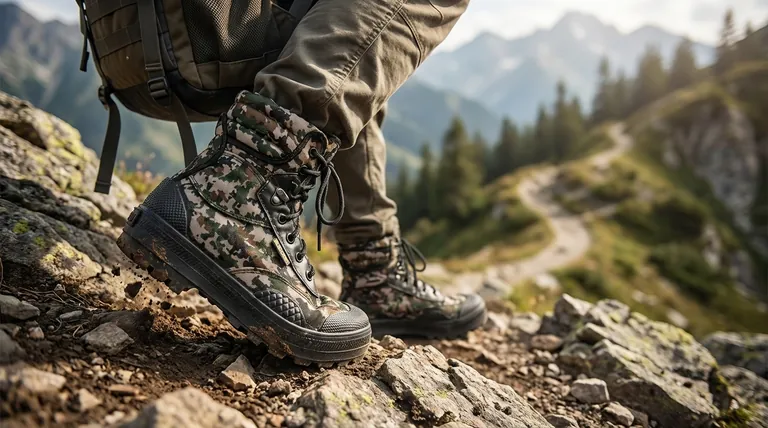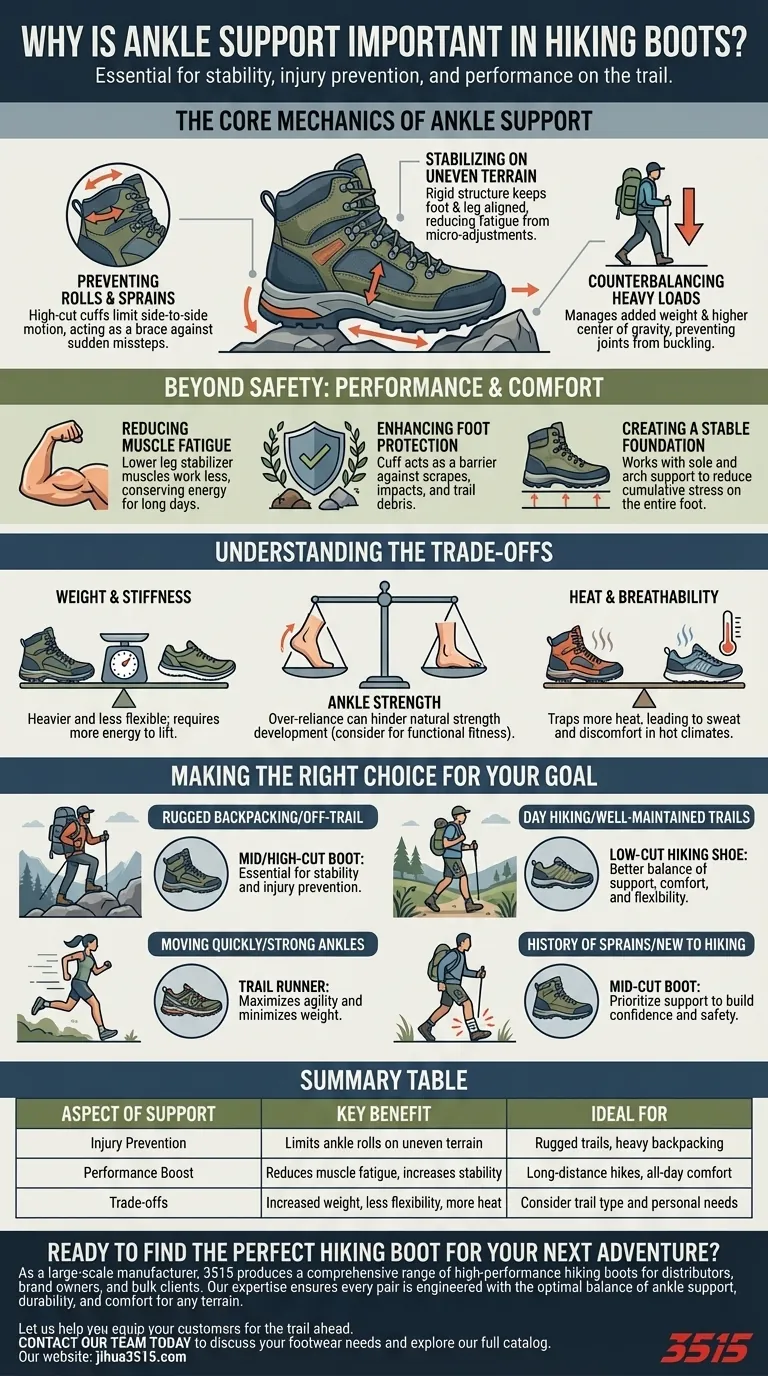The primary function of ankle support in hiking boots is to provide stability and prevent injury on unpredictable terrain. By physically bracing the ankle joint, mid and high-cut boots significantly reduce the risk of rolls or sprains, especially when navigating rocky ground or carrying the destabilizing weight of a heavy backpack. This structural reinforcement is a critical safety feature for serious hiking.
The real goal isn't just to find a boot with "ankle support," but to match the level of support to the specific demands of your hike. While maximum support is crucial for rugged backpacking, it can be unnecessary and even detrimental for simpler, well-maintained trails.

The Core Mechanics of Ankle Support
Ankle support is not a single feature but an integrated system. The height of the boot's collar, the stiffness of its materials, and its lacing system all work together to protect a highly vulnerable joint.
Preventing Ankle Rolls and Sprains
The most common hiking injuries involve the ankle turning inward (inversion) or outward (eversion). A mid or high-cut boot features a cuff that wraps around the ankle, physically limiting this excessive side-to-side motion and acting as a crucial brace against sudden missteps.
Stabilizing for Uneven Terrain
Trails are rarely flat. Roots, rocks, and off-camber slopes place constant, unpredictable stress on your feet. The rigid structure of a supportive boot helps keep your foot and leg in proper alignment, preventing the micro-adjustments that lead to fatigue and potential injury.
Counterbalancing Heavy Loads
Carrying a heavy backpack raises your center of gravity, making you inherently less stable. The added weight increases the force on your joints with every step. Good ankle support helps manage this load, providing the external stability your muscles need to prevent buckling under pressure.
Beyond Injury Prevention: Performance and Comfort
True ankle support contributes to more than just safety. It directly impacts your energy levels and overall comfort on the trail.
Reducing Muscle Fatigue
A well-supported ankle means the small stabilizer muscles in your lower legs and feet don't have to work as hard to maintain balance. This conservation of energy translates directly to less fatigue and soreness over the course of a long day.
Enhancing Overall Foot Protection
The same high-cuff design that supports the ankle also shields it from the environment. It provides a physical barrier against scrapes from branches, impacts from rocks, and keeps trail debris from getting inside your boot.
Creating a Foundation for the Foot
Ankle support works in concert with the boot's other structural elements, like a stiff sole and robust arch support. This complete system creates a stable platform for your entire foot, reducing the cumulative stress that can lead to conditions like plantar fasciitis.
Understanding the Trade-offs
More support is not always better. The most supportive boots come with compromises that are important to understand.
The Cost of Weight and Stiffness
High-cut, highly supportive boots are almost always heavier and less flexible than their low-cut counterparts. This added weight requires more energy to lift with every step, and the stiffness can feel cumbersome on easy, flat trails.
The Question of Ankle Strength
Some experts argue that over-reliance on highly supportive boots can prevent your ankles from developing their own natural strength and proprioception (your sense of body position). This is a consideration for those who want to build functional fitness.
The Heat and Breathability Factor
Taller boots trap significantly more heat and are less breathable than hiking shoes or trail runners. In hot and dry climates, this can be a major factor leading to discomfort, sweat, and blisters.
Making the Right Choice for Your Goal
Selecting the right level of ankle support is about assessing the terrain, the weight on your back, and your own physical condition.
- If your primary focus is backpacking with a heavy load or navigating rugged, off-trail terrain: A mid or high-cut boot is essential for providing the stability needed to prevent injury.
- If your primary focus is day hiking on well-maintained trails with a light pack: A low-cut hiking shoe often provides a better balance of support, comfort, and flexibility.
- If your primary focus is moving quickly or you have strong, healthy ankles: A trail runner may offer all the protection you need while maximizing agility and minimizing weight.
- If you have a history of ankle sprains or are new to hiking: Prioritize a more supportive mid-cut boot to build confidence and provide an extra margin of safety.
Ultimately, choosing the right ankle support empowers you to focus on the trail ahead, not the ground beneath your feet.
Summary Table:
| Aspect of Support | Key Benefit | Ideal For |
|---|---|---|
| Injury Prevention | Limits ankle rolls on uneven terrain | Rugged trails, heavy backpacking |
| Performance Boost | Reduces muscle fatigue, increases stability | Long-distance hikes, all-day comfort |
| Trade-offs | Increased weight, less flexibility, more heat | Consider trail type and personal needs |
Ready to find the perfect hiking boot for your next adventure?
As a large-scale manufacturer, 3515 produces a comprehensive range of high-performance hiking boots for distributors, brand owners, and bulk clients. Our expertise ensures every pair is engineered with the optimal balance of ankle support, durability, and comfort for any terrain.
Let us help you equip your customers for the trail ahead. Contact our team today to discuss your footwear needs and explore our full catalog.
Visual Guide

Related Products
- Wholesale High-Traction Camo Boots - Custom Manufacturer for Brands
- Factory-Direct Wholesale Canvas Boots with High-Traction Rubber Soles
- High Performance Fire-Retardant Waterproof Safety Boots
- Wholesale Safety Footwear Manufacturer for Bulk & Custom OEM Orders
- Factory Direct Wholesale Rain Boots Durable Waterproof & Fully Customizable
People Also Ask
- What are the key features of the new line of camo boots? Built for Extreme Cold & Rugged Terrain
- What are some real-world applications of military camouflage boots? From Tactical to Trendsetting
- What historical event marked the first use of camouflage in military apparel? The Napoleonic Wars' Tactical Shift
- Why might wearing multiple pairs of socks be counterproductive? Avoid This Common Cold-Weather Mistake
- How did camouflage use develop during the World Wars? From Artistic Disruption to Scientific Concealment



















